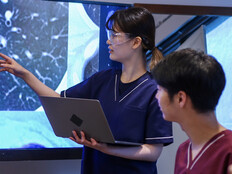4 Steps to Jump-Start Modern Learning Environments at Universities
Active learning classrooms have transformed how K–12 schools are delivering their curricula, and universities are starting to take notice.
This transformative model creates a collaborative environment through student-centered learning and supported technology.
Replacing traditional lectures, active learning gives students a constructive role in the learning process. Research shows that ALC methods provide substantial learning advantages.
These benefits include increased self-reliance, more meaningful connections to content and ongoing cognitive development. Many universities are understandably eager to transition, but it needs to be done correctly.
1. Start by Creating a Modern Learning Culture
An ALC approach is meant to foster a stronger platform for learning, benefiting both students and instructors. Start with a few strategies to incorporate on a daily basis. Consistency will establish expectations for each exercise, and anticipated outcomes will develop over time.
The University of Michigan has put together a comprehensive list of simple instructional activities such as “minute papers” and “think-pair-share” sessions that can lay a solid foundation on which to build holistic ALC platforms. Using collaboration platforms like G Suite in conjunction with these strategies can be a first step toward active learning.
2. Establish a Purpose Through Specific Educational Goals
It is essential to identify core learning targets and decide what practices will best assist students in reaching those goals. At California State University, Los Angeles, the department of chemistry and biology has created numerous activities with different purposes, including cooperative learning and critical-thinking motivators.
“Concept mapping” is an example of an ALC practice where students create visual representations of the connections between terms or concepts covered in the course material, enabling them to organize and find relationships in the information. Tablet devices such as iPads are great tools to support group activities like these.
3. Build a Modern Classroom with the Space Available
An ultramodern learning space isn’t essential to implement active learning. The key is to consider what technology will work best in the space that you have. Quizdom is a student response system that creates an interactive learning environment, regardless of classroom size.
Software solutions can give students tools to participate throughout the class and provide real-time feedback. However, hardware solutions such as interactive projectors, like those from Epson, can significantly enhance an ALC space.
Yale University’s Technology-Enabled Active Learning classroom takes this fully tech-immersive approach. Accommodating 126 students and featuring eight whiteboards, five projection screens and 14 flat screen displays, the space facilitates flexible grouping and multimodal media engagement.
4. Train Professors to Use New Tech
As with any new approach, it is critical to give instructors opportunities to discuss and share strategies for implementing ALC strategies. Faculty will need time to adopt strategies that work for specific content.
It is important to provide continuous support throughout the academic year to see effective results. Ohio University’s Office of Instructional Innovation is tackling this challenge by discussing active learning in workshops each semester.
Universities are beginning to recognize the educational value of active learning strategies, but if they are to evolve into truly modern learning environments, it is essential to invest in the right technology to facilitate that transformation.








